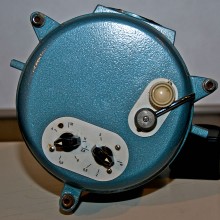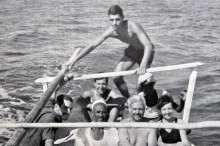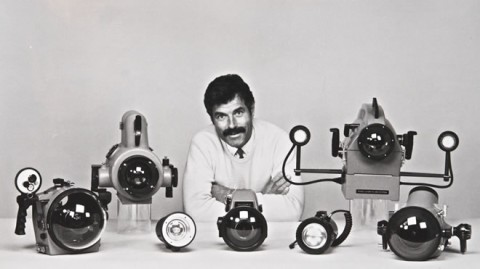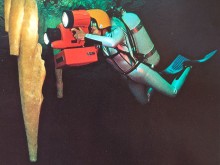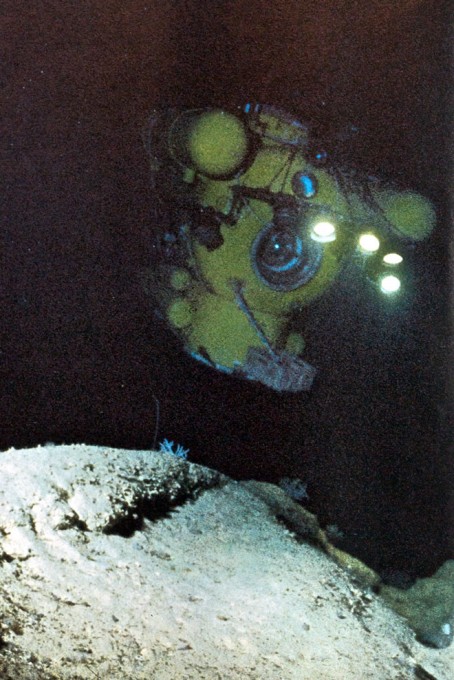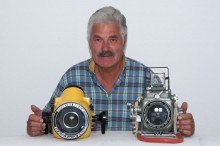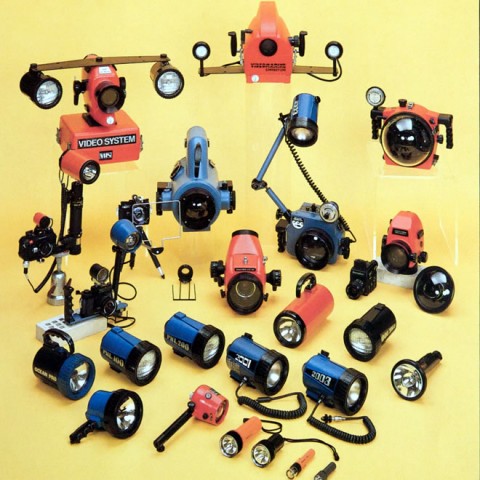Today I would like to introduce an extremely versatile personality and famous designer and “Rolleigrapher”:
I have known him for a long time. When I met him first, he was still building his famous underwater camera housings. It was winter, a very cold day. On a slippery, icy road, I fell down with the housing for my Rollei SL66. It dropped so badly that afterwards it was not watertight anymore. On my next dive, a lot of water drops came in everywhere. Although I could not see any cracks, they were still evident, and the housing needed to be sealed again. For this process, which was recommended for all of the new thin-walled aluminium moulded housings, its paint needed to be removed again and afterwards it was dipped in a synthetic liquid resin. In order to seal all the tiny capillary cracks, the whole process had to be done under pressure. So the resin could bond with the aluminium and then it had to be hardened under heat.
Later on Wulf built a second front part with a dome port for my 30mm f3.5 Zeiss F-Distagon fisheye lens, which opened up a completely new perspective under water for me. Due to its oversized wide angle and close focus distance, I got much better results with my Rollei SL66 from then on.
But let us start our story straight from the beginning: Wulf H. Koehler, (the “H” stands for Hinrich), was born July 2nd, 1940 in Koenigsberg on the Baltic Sea. It is the time of the Second World War; Wulf’s father is called up, and the whole family now depends on his mother. Due to the fact that the Baltic Sea is so close by, Wulf becomes familiar with water pretty quickly, but his carefree childhood ends with the collapse of the eastern front, followed by a hasty escape from the Russians, ending in Thuringia, in the eastern part of Germany, where he soon attends elementary school. Fortunately his father survives captivity as a prisoner of war in Russia. After his repatriation, he again works in his profession as an artistic painter. He restores stucco works and ceiling frescos in a lot of different castles, churches and public buildings, not only in the eastern, but mainly in the western part of Germany, too. This gives him the possibility of comparing the living conditions in both parts of Germany pretty well. The Wall does not exist yet and Wulf is only 10 years old, and has two siblings now; their place of residence changes again, this time to Darmstadt in Western Germany. The family takes the first opportunity during a dark night and escapes.
In 1954, during his holidays in Yugoslavia, Wulf undertakes his first snorkel adventures in the Mediterranean. He likes the new hobby very much, but at almost the same time, two more passions emerge. The passion of photography and – due to his handicraft skills – he also likes to build gliders and motor driven airplane models. Wulf mixes his special fuel himself, but to his regret his limited means do not allow him to buy his own remote control device.
1955 he joins the Darmstadt Underwater Club, one of the first few diving clubs, which just set up the German Sport Diving Association (VDST). There he takes his first diving lessons, and in 1957 he passes his “open water diving examination” under the ice of a gravel-pit in the neighbourhood of Darmstadt. The very same year, he builds his first underwater camera housing, made of sheet steel for his Praktica slr-camera, with very disappointing, or even ‘crushing’ results. The following new design, this time made of cast aluminium alloy, is too heavy and does not satisfy his expectations. One year later, all criteria get resolved and everything works perfectly. This graceful underwater housing, named the “Darmstadt Model” becomes so popular that he starts building some units for friends and underwater photographers of other diving clubs.
In 1959 he finishes school, passing his final examinations qualifying him for the Technical University in Darmstadt. He starts his studies in Mathematics and Physics. After his pre-diploma, he changes his mind and decides to become a mechanical engineer, specialising in aeronautics and control engineering. Besides his studies he still goes diving, using the first breathing gear available on the market in Germany after the war, a rebreather system (“aqualung”) using pure oxygen. Since its flexible breathing bag starts getting some little leaks pretty soon, he builds a new one and uses it successfully in a lot of gravel-pits in the area around his hometown. After a few dives he is not satisfied with the technical perfomance, so he changes again, this time diving with compressed air, which in general works less dangerously.
The two tanks are painted in a glowing orange-red. This is very unusual, but eye-catching and this provides him later – due to its photogenic effect – the opportunity to act as an underwater model.
In the meantime, he has been promoted to vice chairman of the DUC Darmstadt, the local Diving Club. As such, Wulf gets the chance to participate in the “German Coral Expedition” to the Red Sea.
Dr. Georg Scheer, who was a member of two Hans Hass expeditions in 1954 and 1957, is the leader of this adventure trip to the country of Sudan.
The expedition lasts for three months. In Port Sudan Wulf meets Ludwig Sillner, the most well-known underwater photographer world-wide in those days. With him he visits the famous wreck of the “Umbria” close to the Wingate Reef, off Port Sudan.
After this expedition he becomes president of the Darmstadt Diving Club for the following 12 years. Additionally he starts further careers in the German Sport Diving Association: 1969 he becomes chairman and dive master of the youth group of the VDST, which gives him the opportunity to travel with young divers to the Sinai coast of the Red Sea, at that time still part of Israel. In 1971 he is invited to participate in the 1st Symposium of the World Underwater Federation (CMAS= Confédération Mondiale des Activités Subaquatiques) in Havanna-Cuba, where he gives a talk on his spectacular dives, finding bones of mammoths and other huge animals from the last ice age in several gravel-pits along the river Rhine. After Ludwig Sillner’s death, Wulf takes over Ludwig’s former function for seven years. He is now chairman of the department for underwater photo and film within the VDST. In this position he also creates the desired trophy, the “Caméra Louis Boutan” medals in bronze, silver and gold for the winners of this German underwater photo competition.
In 1968 he graduates from Darmstadt university. He starts his professional career as a sales engineer. He works for a well-known German-American company in Darmstadt selling analytical instruments. A little later, in 1972 he founds his own company “WKD OceanOptics Germany”.
At the beginning, he designs and manufactures underwater camera housings, later on some interesting film projects show up. Wulf starts to shoot a documentary film for the British television company, Anglia Survival Ltd. It is about the history of an Italian warship, the well-known wreck of the “Umbria” near Port Sudan.
On January 1st 1975 he receives an award and becomes a member of the “National Geographic Society”. He is honoured for the very special design of the famous underwater housing, the “OceanEye”, built for the Nikon F3-motordrive. This new tool was developed for David Doubilet, one of the best uw-photographers at that time.
The housing consists of three parts, and is pressure tested for a depth of 300 meters. The “OceanEye” is equipped with a 180° (degree) dome-port, all available Nikon lenses can be used. The huge action finder of the Nikon F3 allows the uw-photographer to compose the underwater shots perfectly. The motor-drive provides exposures up to 6 frames per second. The film or the lens can be changed very quickly, since the camera stands in the centre part of the housing.
Only months later Wulf gets a call from Burbank Studios in Los Angeles. He gets an offer to become the “underwater project engineer” of the Hollywood feature film “THE DEEP”, a very spectacular job. For more than 10 months he works at locations like the British Virgin Islands, Bermuda and at the Great Barrier Reef in Australia.
In 1977 he meets a well-known German ethologist, Dr. Hans Fricke in Eilat at the Red Sea. He helps building a new project, “Neritika”- an underwater lab, in which Wulf and Hans live for two weeks on a saturation dive at 13 meters below sea level. Within the following years, Wulf does several dive trips, e.g. to Australia, to the Galapagos Islands, to Hawaii and to the Antarctic.
In 1979 his former employer calls up, offering him such a well paid job that he cannot refuse. Almost at the same time he gets an order from JVC to develop the “VideoMarin 200”, the first autonomous underwater video system world wide, which is introduced at “Photokina” in Cologne in 1980. Although it is a huge piece of equipment, this new video-system is sold world-wide, even to the Turkish and Libian government.
In the same year in Eilat at the Red Sea he helps to build the “GEO”, a research submersible, a two-man diving vessel, which is capable of submersing down to 200 meters. Wulf equips that vehicle with seven, battery-driven floodlights, 250 watts each, specially designed for this project. One day he mounts his OceanEye housing with the Nikon-F3 motordrive on the ocean floor. Two powerful strobes are mounted to the housing. At the depth of 200 meters he releases the camera with a laser remote-control unit and gets spectacular snap-shots of the dive boat itself, published as a double page photo in the November-1982 issue of the German GEO-magazine.
In March 1976 the way gets paved for a serious co-operation with Rollei: Initially the management wants Wulf to manufacture an improved version of the legendary “Rolleimarin”- housing using the “Rolleiflex 2,8f”. Wulf refuses to take this order. From his point of view the “Rolleimarin” was the top uw-camera during the pioneer time of underwater photography. But now the time has come for the application of a very much more progressive all-round camera system, the “Rolleiflex SL66”. This camera has a lot of fine features. In close-up mode, there is no need of any parallax compensation. All its possibilities of land photography can also be transferred and used under water. Besides the film magazine for 120 and 220 film rolls and its different interchangeable lenses, it has – out of the ordinary – a built-in bellows, which allows the photographer to shoot from infinity down to two inch distant close-ups by just turning the focus knob, with no other modification of the housing. This feature makes the “Rolleiflex SL66” absolutely ideal and unique to take underwater shots.
Wulf tries to name his new baby “RolleiMarin SL66” which is not allowed due to patent laws of the Rollei company. Therefore he calls the housing “AQUAMARIN WKD-SL66”. The advantages of this new piece of equipment are so impressive that a new world of uw-photography is opened. Within a very short time the housing gets very popular and is sold to all countries around the globe. Most of the serious underwater photographers world-wide use it with a lot of respect and obtain the best results in all fields. Owners of this unit show up as winners of different photo competitions everywhere.
Within the following years some new designs and constructions come up and Wulf now is entitled to use the old trade name “Rolleimarin”, as e.g. for the “RolleiMarin WKD-SLX” and its successor models 6002, 6006 and 6008, as well as for his smallest housing for the miniature motor camera the “Rolleiflex SL 3003”. At the beginning, this “RolleiMarin 3003” is manufactured out of cast aluminium alloy, but later on it is manufactured out of carbon fibre reinforced resin, which makes the housing very light and neat. Equipped with several ports, it can be used with a lot of different lenses, and – as a matter of fact – a TTL-flash can be connected. It is provided with a 30° viewfinder port, like all the former housings Wulf has built. Other advantages of that housing are the interchangeable film magazine for 36 or 72 exposures, the built-in motor drive and the two different battery packs, one for 5AA-cells, the other for rechargeable NiCd-batteries.
Besides such top quality products, he also builds other housings for electronic strobes and unusual special housings, e.g. for the professional movie camera “Arriflex 16 SR-II High Speed”.
This housing has perfect neutral buoyancy; it can be moved and used under water with two fingers only, independent of the shooting direction. For the first time Wulf installs a very highly sophisticated lens system, an endoscopic rod lens, that sticks out of the front port like a pencil. With this invention, the cameraman can shoot tiny creatures in extreme close-up, which show up later on the screen like monsters on the sea.
During all this time, Wulf become acquainted with a lot of famous people, the crème de la crème of the underwater world, a lot of well-known divers, artists, writers, editors, film producers and film stars, scientists and underwater photographers. One of them, Jacques Piccard with his new scientific submarine, in which he later undertook a drift dive within the Gulf Stream. Wulf also became friends with Ron and Valerie Taylor of Australia.
Leni Riefenstahl, a great photographer repeatedly tries to talk him into letting her take nude pictures of him, unfortunately without success. He looks handsome, sun tanned, black haired, 189 cm tall, slim, strong and muscular. Meeting him today, to me he looks almost unchanged, even with his grey hair, just a little bit more dignified.
As I mentioned before, Wulf was fascinated with model airplanes when he was a youngster. The dream of flying became reality in 1980. At that time he studied and sat in school again to get his “Private Pilots Licence” (PPL) and the English and German Flight Radiotelephone Operator’s Certificate.
In the late eighties he reads an issue of the American “Playboy Magazine”. The advertisement of an experimental airplane kit catches his attention. Building his own private plane sounds fascinating to him. Wulf calls the manufacturer in Florida, USA and after a demo-flight, he immediately signs a contract to purchase a kit. It takes another six years with a working time of almost 3000 hours until he can start his first flight in his self-built plane on the 27th of March 1998 from the Melbourne airport in Florida. It is a four-seater, a Canard type plane, the fuselage is built like a sandwich, a double hull of glass and carbon fibre compounds. It is IFR-equipped, fast, converted with long range tanks, allowing trips up to 2000 miles. It has a 200 hp fuel injection Lycoming engine in the back, a German constant speed propeller and a retractable gear system, a very slick and elegant bird.
In those years, diving and manufacturing underwater camera housings are not his first priority anymore. General Aviation and flying becomes a new part of his life. Together with his lady friend, Wulf visits a lot of places around Germany, followed by a four-week flight safari to five different African countries. Travelling within Europe, Wulf visits the islands of the Azores twice.
The fresh air, the breeze of the ocean, combined with a moderate climate, the pretty nature and scenery with its lush and colourful vegetation raises the desire to live there after being retired.
He quickly finds a suitable piece of property at the south shore of the main island. It takes him 9 months to finish the design of his dream-house. The drawings become a reality and the raw white building is a new landmark at the shoreline of Sao Miguel island.
Due to his ambitious and impetuous life style, Wulf suffers a heart attack in 1999. This forces him to take life a little easier. At least he promises himself to do so, but an outsider does not see any changes in his habits. Fortunately he quickly recovers. In 2002 he terminates his employment contract with the company, for which he worked for 23 years, besides all his other above-mentioned activities. The interior work of his dream-house, also done by himself, is finished in 2004. He moves in and the year 2005 brings him a lot of leisure time.
What would you do under such conditions? Well, Wulf takes lessons in a flight-simulator again and gets the feeling of flying a “Jumbo-Jet 747” and the “Airbus 340”. Additionally, Wulf works as an artist, a sculptor and creates beautiful objects that resemble heads and ball-shaped pieces. They are made of special brass, have a nicely structured shiny surface and can be put together like a 3-dimensional puzzle.
Within the last five years, Wulf returns to his major hobby. He visits various known and unknown dive sites, such as the Red Sea along the Sudanese coast, he travels to Papua New Guinea, Malaysia and dives in the “Blue Holes” of the Bahamas.
Like many other photographers, Wulf changes from film to digital photography. He buys two “Nikon D-300” cameras, a couple of lenses and, needless to say, he builds his own underwater housing with different ports for that camera. Restless as Wulf is, he founds a new company in the Azores promoting the use of alternative forms of energy. To show what can be done, he installs a solar-driven floor heating system in his house, photovoltaik panels and a wind turbine to supply the necessary electrical power.
I wish Wulf and his company “SolarPro Engineering” the best for the future. Perhaps, who knows, we will see him one day on a completely different mission: maybe, with his attractive sculptures somewhere at the vernissage of his own art exhibition. Wulf will celebrate his 70th birthday pretty soon


